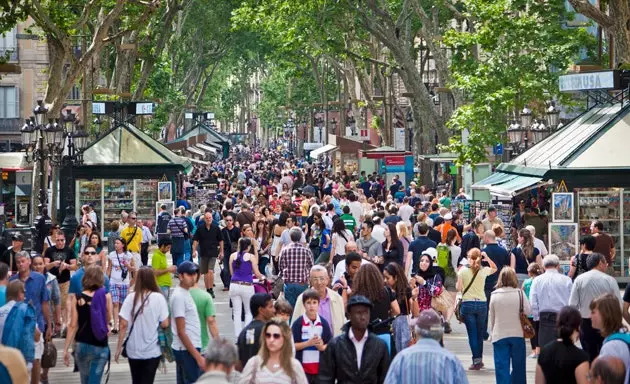
The Rambla of Barcelona
This busy street was created in the 14th century to serve as a channel to carry rainwater. Today he remains faithful to his mission of channeling, although instead of waters they are walkers. Artists, cafes, kiosks, churches with history, flower stalls, a mythical theater... Barcelona's Rambla has it all and it's one of the most active points of the city, a real hive of people , especially on weekends. At every step along this street, you can find traditional shops, many of them with modernist facades.
Although from an architectural point of view it does not benefit from the presence of spectacular buildings, the palaces of March, Moja and Virreina, the church of Betlem or the exotic Casa Quadros should be highlighted. However, there are two elements that determine the richness of La Rambla: the Teatre del Liceu and the La Boquería market.
The origin of its name comes from the Arabic word 'ramla' , which refers to a sandy area, because in the old days, before the area was urbanized, the river of Malla , a stream that flowed into Plaça del duc de Medinaceli and which, logically, created a sandy area as it passed.
East art deco dragon and Chinese style holding a lantern is also found in The Rambla , In the call house of umbrellas , and was designed as an advertising claim for an old umbrella store, hence there is also one of them below.
Rodin's The Thinker is not the only sculpture that is racking its brains to understand the meaning of life: joseph granyer , greatly influenced in his career by cubism, surrealism and a constant fascination with the animal world, he devised the thinking bull , located in the Rambla de Catalunya since 1972. Not long ago he suffered an attempted robbery, but he is still there, focused. Close, the flirtatious giraffe , another sculpture by the author, also watches life go by. To look for them has been said.
At the height of the Gran Teatro del Liceo, if you look carefully where you step, you will find a mosaic of the very Joan Miro , a surrealist circle with the most characteristic colors of the artist's work, installed there in 1976 as a universal symbol of totality and perfection.
Map: See map
Address: La Rambla, Barcelona See map
Guy: Neighborhoods
